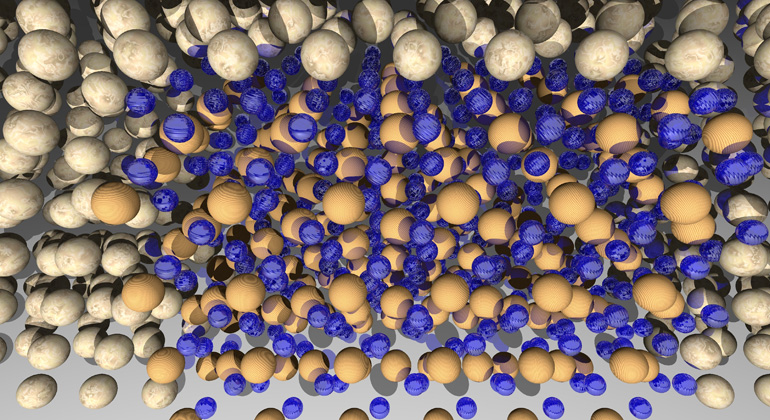Magnesium still has the potential to become an efficient hydrogen store
It is easy to be optimistic about hydrogen as an ideal fuel. It is much more difficult to come up with a solution to an absolutely fundamental problem: how to store this fuel efficiently?
A Swiss-Polish team of experimental and theoretical physicists has found the answer to the question of why previous attempts to use the promising magnesium hydride for this purpose have proved unsatisfactory – and why they may succeed in the future.
Hydrogen has long been seen as the energy carrier of the future. However, before it becomes a reality in the energy sector, efficient methods of storing it must be developed. Materials selected in such a way that, at low energy cost, hydrogen can first be injected into them and then recovered on demand, preferably under conditions similar to those typical of our everyday environment, appear to be the optimal solution. A promising candidate for hydrogen storage appears to be magnesium. Converting it into magnesium hydride, however, requires a suitably efficient catalyst, which has not yet been found. The work of a team of scientists from Empa – the Swiss Federal Laboratories for Materials Science and Technology in Dübendorf, and the Department of Chemistry at the University of Zurich as well as the Institute of Nuclear Physics of the Polish Academy of Sciences (IFJ PAN) in Cracow, has shown that the reason for the many hitherto years of failure lay in an incomplete understanding of the phenomena occurring in magnesium during hydrogen injection.
The main obstacle to the uptake of hydrogen as an energy source is the difficulty of storing it. In the still rare hydrogen-powered cars, it is stored compressed at a pressure of around 700 atmospheres. This is neither the cheapest nor the safest method, and it has little to do with efficiency: there is only 45 kg of hydrogen in one cubic metre. The same volume can hold 70 kg of hydrogen, if it is condensed beforehand. Unfortunately, the liquefaction process requires large amounts of energy, and the extremely low temperature, at around 20 Kelvin, must then be maintained throughout storage. An alternative could be suitable materials, for example magnesium hydride, which can hold up to 106 kg of hydrogen in a cubic metre.
Magnesium hydride is among the simplest of the materials tested for hydrogen storage capacity. Its content here can reach 7.6% (by weight). Magnesium hydride devices are therefore quite heavy and so mainly suitable for stationary applications. However, it is important to note that magnesium hydride is a very safe substance and can be stored without risk, for example, in a basement, and magnesium itself is a readily available and cheap metal.
“Research on the incorporation of hydrogen into magnesium has been going on for decades, yet it has not resulted in solutions that can count on wider use
”, says Prof. Zbigniew Lodziana (IFJ PAN), a theoretical physicist who co-authored an article in Advanced Science, where the latest discovery was presented. “One source of problems is hydrogen itself. This element can effectively penetrate the crystal structure of magnesium, but only when it is present in the form of single atoms. To obtain it from typical molecular hydrogen, a catalyst efficient enough to make the process of hydrogen migration in the material fast and energetically viable is required. So everyone has been looking for a catalyst that meets the above conditions, unfortunately without much success. Today, we finally know why these attempts were doomed to failure.
”
Prof. Lodziana has developed a new model of the thermodynamic and electron processes occurring in magnesium in contact with hydrogen atoms. The model predicts that during the migration of hydrogen atoms, local, thermodynamically stable magnesium hydride clusters are formed in the material. At the boundaries between the metallic magnesium and its hydride, changes in the electronic structure of the material then occur, and it is these that have a significant role in reducing the mobility of hydrogen ions. In other words, the kinetics of magnesium hydride formation is primarily determined by phenomena at its interface with magnesium. This effect had so far not been taken into account in the search for efficient catalysts.
Prof. Lodziana’s theoretical work complements experiments performed in the Swiss laboratory in Dübendorf. Here, the migration of atomic hydrogen in a layer of pure magnesium sputtered onto palladium was studied in an ultra-high vacuum chamber. The measuring apparatus was capable of recording changes in the state of several outer atomic layers of the sample under study, caused by the formation of a new chemical compound and the associated transformations of the material’s electronic structure. The model proposed by the researcher from the IFJ PAN allows us to fully understand the experimental results.
The achievements of the Swiss-Polish group of physicists not only pave the way for a new search for an optimal catalyst for magnesium hydride, but also explain why some of the previously found catalysts showed higher efficiency than expected.
“There is much to suggest that the lack of significant progress in hydrogen storage in magnesium and its compounds was simply due to our incomplete understanding of the processes involved in hydrogen transport in these materials. For decades, we have all been looking for better catalysts, only not where we should be looking. Now, new theoretical and experimental results make it possible to think again with optimism about further improvements in methods of introducing hydrogen into magnesium
”, concludes Prof. Lodziana.
On the Polish side, the research was funded by the National Science Centre, and by the Swiss National Science Foundation on the Swiss side.
- „Why Hydrogen Dissociation Catalysts do not Work for Hydrogenation of Magnesium” | Advanced Science, 2304603, 2023 | DOI: https://doi.org/10.1002/advs.202304603
Source
Institute of Nuclear Physics PAN | IFJ PAN Press Office 2024 / EurekAlert!: [https://www.eurekalert.org/news-releases/1032404]








